The annual Wildebeest Migration of around 1.5 million wildebeests, zebras and antelopes is visible from space as one of the Seven Natural Wonders of Africa.
I've followed the great herds on their brutal journey north many times. It's incredible to think that some 250,000 animals are lost to predators, river crossings and fatigue during the migration every year.
I also caught the wildebeest on their return to breeding grounds when half a million calves restart this circle of life in the south of the Serengeti National Park.
In this article, I'll share my best insights on the Great Wildebeest Migration and everything tourists can expect on this remarkable journey.
Let's get started.
My Quick Takeaways:
The Great Wildebeest Migration involves approximately 1.5 million wildebeest, zebras, and antelopes moving through the Serengeti and Masai Mara ecosystems annually.
Migration Route:
- Calving Season (February - March): Herds gather in the southern Serengeti for birthing.
- May: Begin moving northward through the Moru Kopjes and west of Seronera.
- June: Some cross the Grumeti River; others head directly north.
- July - October: Reach the Northern Serengeti and Masai Mara; notable Mara River crossings occur.
- November: Start returning south as short rains commence.
Best Viewing Times:
- Calving Season: Late January to February in the southern Serengeti.
- River Crossings: June to September at the Grumeti and Mara Rivers.
Predators and Scavengers: Lions, cheetahs, leopards, hyenas, crocodiles, jackals, and vultures play crucial roles in the ecosystem during the migration.
Interesting Facts:
- The term 'wildebeest' is derived from Dutch, meaning 'wild beast'.
- Calves can walk and run within minutes of birth.
- Wildebeest can reach speeds up to 80 km/h (50 mph).
The Great Wildebeest Migration FAQs
In this article I will answer all your burning FAQs on the Great Wildebeest Migration. I have also included some fun facts about wildebeest that you might not already know at the end of the article.
Now, let's start answering those Great Wildebeest Migration FAQs!
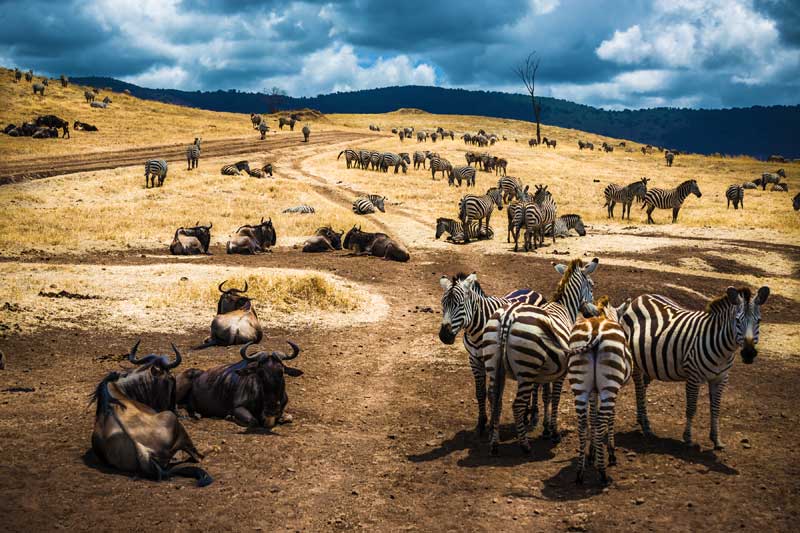
Why do the Wildebeest migrate?
Wildebeest are grazers that need good quality grasses to survive and reproduce. The Serengeti is a huge area and rains fall at different times in different areas producing nutritious grasses. Serengeti Animals must follow this rainfall to find enough food to eat. So, the large herds are constantly on the move to find food and water.
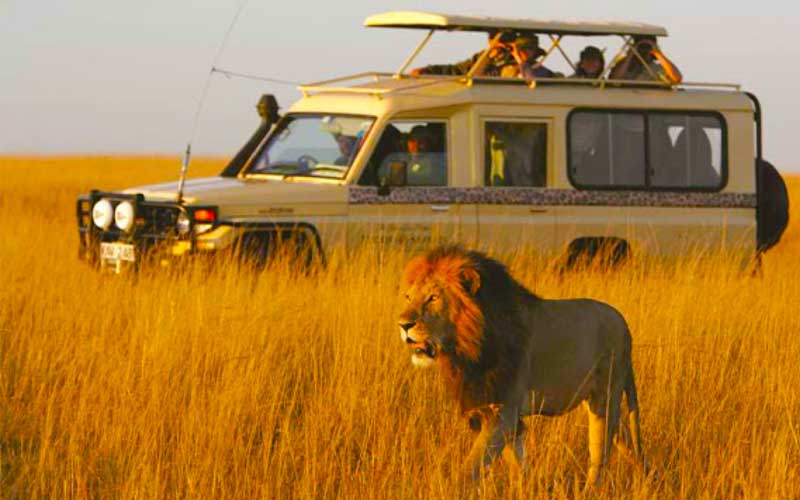
Plan your Safari experience
Check out these amazing deals on epic safari experiences now.
What starts the Wildebeest Migration?
The signal for herds to start their journey is the onset of rainfall which they appear to be able to sense from up to 50km away. Some research also suggests that movement may be triggered by lightning or thunder that the animals see on the horizon but this is yet to be proven.
Which tour? Here are 5 Serengeti safari tours I highly recommend:
- Group Camping Safari that includes Tarangire and Ngorongoro (4 days)
- Budget Serengeti Safari (5 days)
- Scenic Northern Tanzania Safari (7 days)
- Serengeti Trail that includes Ngorongoro (8 days)
- Best of Kenya and Tanzania (incl. 6 national parks) (12 days)
See more Serengeti safari deals.
What route do the animals use to migrate?
The wildebeest migrate in a circular route. Usually, the Calving Season (February to March) in the southern parts of the Serengeti National Park counts as the starting point.
The northern parts at the Mara River and Kenya’s Masai Mara are the endpoints when the herds start to move back down to the southern plains along the eastern sections of the park.
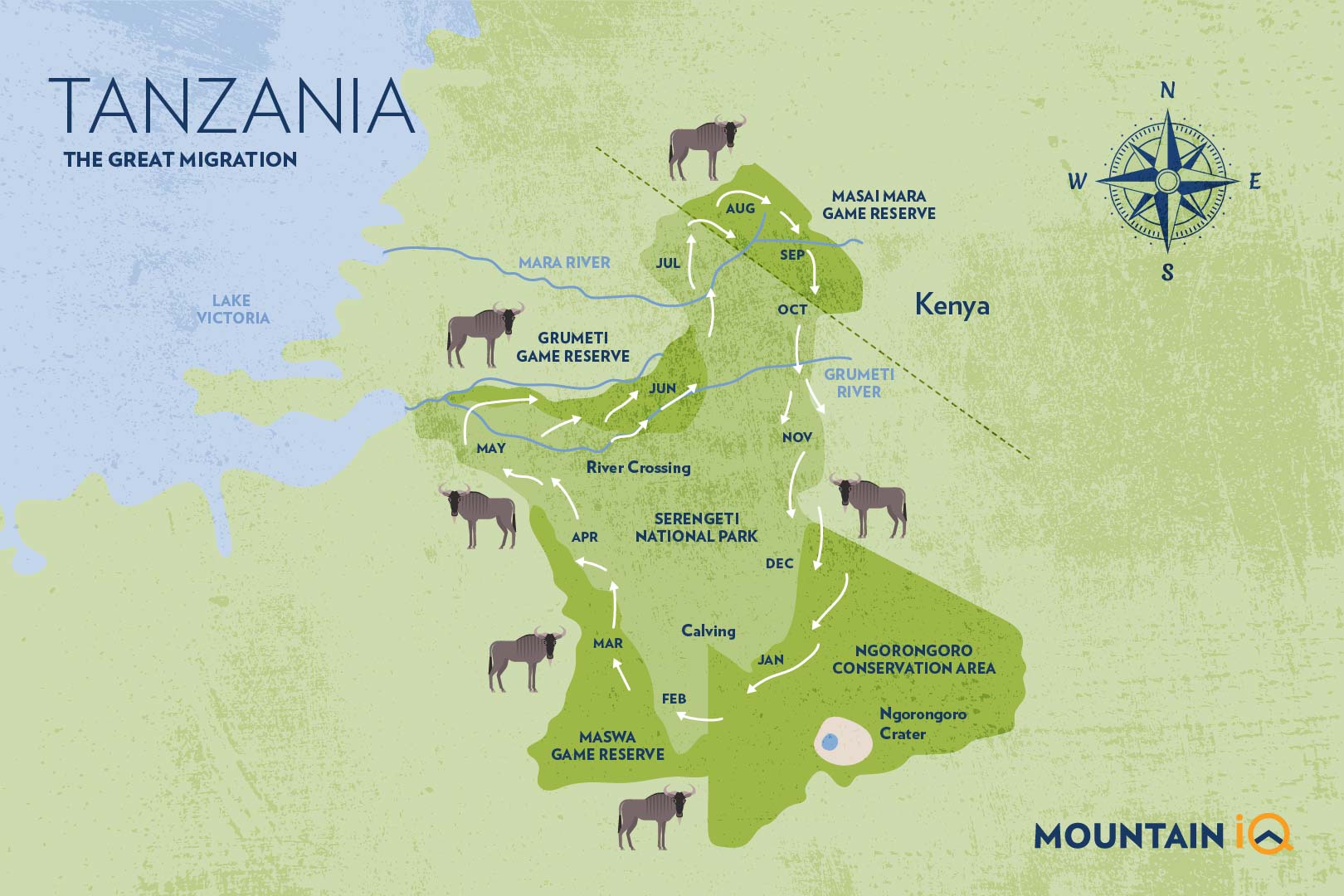
What animals participate in the Great Migration?
There are a number of animals that participate in the Great Migration annually, many of which are wildebeest and buffalo herds as well as some of the notable Big 5 predators.
Predators
Predators including lions, cheetahs, leopards, wild dogs, hyenas and crocodiles pick off the old and weak animals keeping populations healthy and their numbers stable.
Too many wildebeests would destroy the vegetation, leaving the young and healthy to starve.
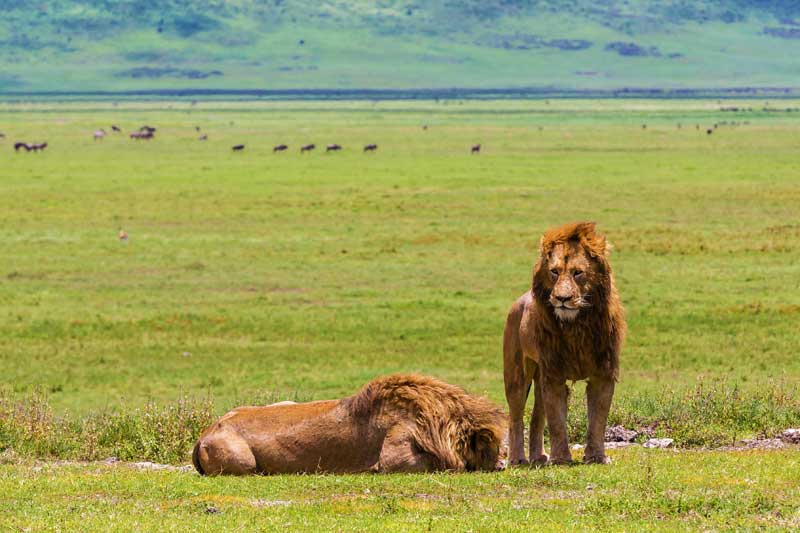
Scavengers
Jackals, vultures and other scavengers pick at the carcasses left behind. Maggots feeding on the carcasses are also valuable food for smaller creatures like mongooses. The decomposing matter is an important source of nutrients for the grasses.
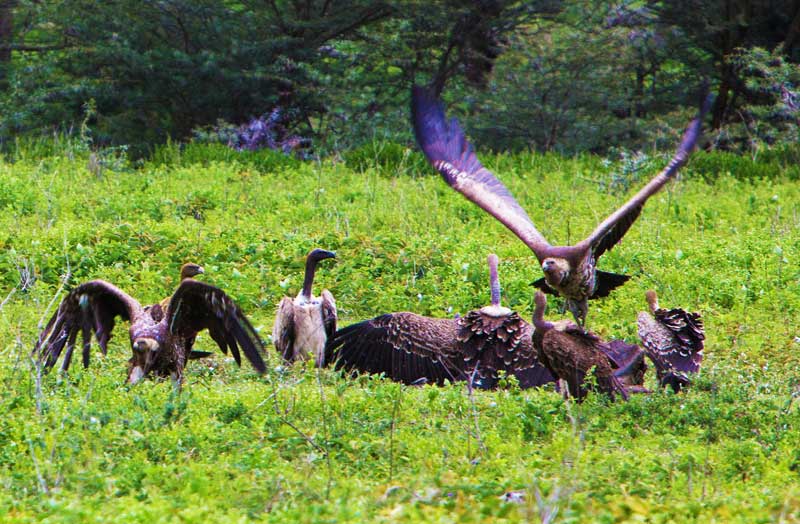
Grazing Animals
Almost 300 zebras and hundreds of gazelles travel alongside the wildebeest during the migration. These game species don’t compete for food as the zebras eat the top, tough part of the grasses, opening up the shorter grass for wildebeest to eat.
They then clear the way to the young grasses which gazelles prefer. These groups of thousands of animals also leave behind droppings which fertilize the soil for the following seasons.
The great wildebeest migration is the heart of the Serengeti ecosystem. Wildebeest are true grazers and prefer grassland and savannah.
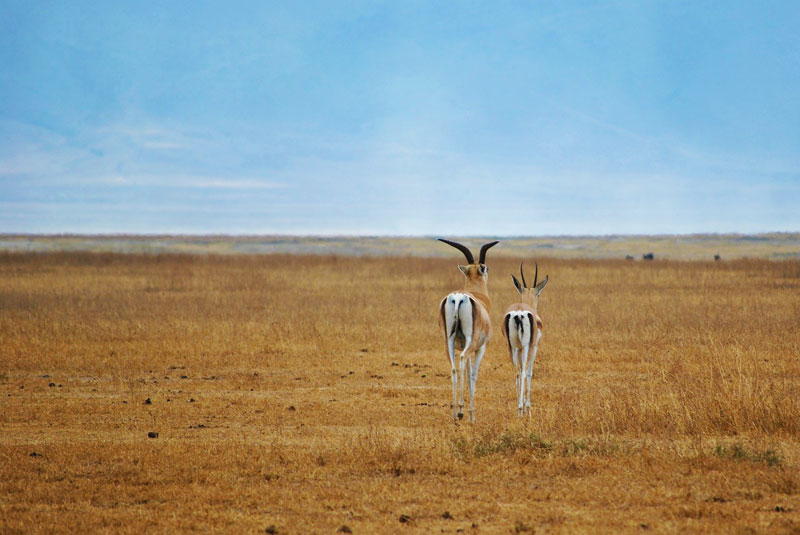
Where can I see the Great Migration?
Theoretically, you can see the Great Migration at any time. The Migration doesn’t really have a start or endpoint but is rather a circular motion going clockwise through Northern Tanzania and Southern Kenya throughout the year.
My Pro Tip: See more on our dynamic Tanzania Safari Map and the best times of year to visit Tanzania and Kenya.
The route follows the 5,700 sq mile Serengeti National Park (97% of the ecosystem) to the Northern boundary of the Serengeti ecosystem in Kenya’s Masai Mara (3% of the ecosystem).
The animals don’t always stick together but break up into mega-herds which take different routes to get to the Masai Mara in Kenya.
Even though the direct route is 500km (300miles), each animal will journey roughly 800km (500miles) and frequently go back and forth, side to side and even remain in certain areas for days or weeks.
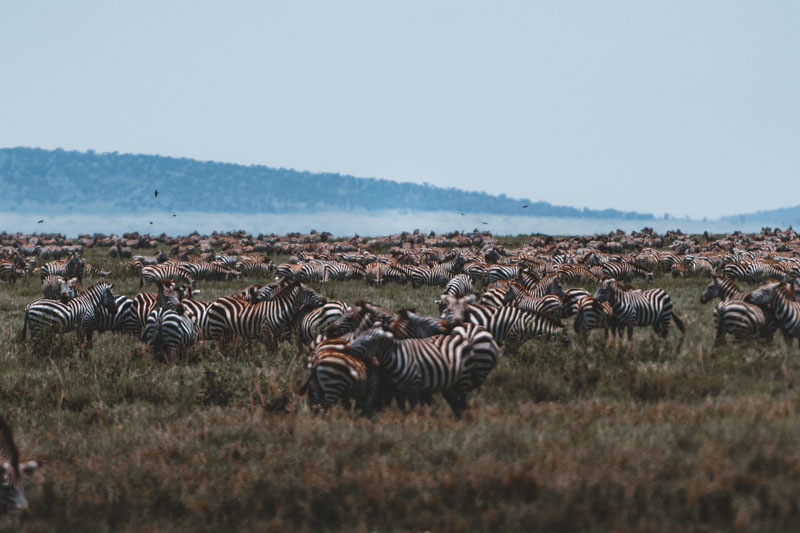
When can I see the Great Migration?
As the herds of animals are constantly on the move, the best time and place to view the migration depends on the season and what you want to see.
Generally speaking, the calving season in February-March and Crossings of the Mara River are fantastic times for your Serengeti safari.
Below is a month-by-month guide to where the herds will end up on their migration journey with a detailed description afterwards.
Time of year | Area | What to expect |
|---|---|---|
January | Southern Serengeti | Massive herds grazing on open plains |
February-March | Southern Serengeti | Peak calving season, baby grazing animals. Lots of predator activity |
April-May | Western and central Serengeti | Males competing over females, mating |
June | Grumeti River, central Serengeti | River crossings, crocodiles |
July-August | Grumeti reserve, Ikorongo, central Serengeti | Moving herds spread out across a wide area |
September | Mara River, northern Serengeti | Biggest River Crossing, crocodiles |
October | Western Loliondo and Lobo area of Serengeti National Park | Moving south to the Southern Serengeti |
November-December | Southern Serengeti | Short rainy season, herds arrive late November |
December-January
Animals are moving from the northeast region of the Serengeti National Park southwards towards the plains surrounding Lake Ndutu in the Ngorongoro Conservation Area between December and January.
At this time, many female wildebeest are heavily pregnant. This is a difficult time of year to predict migration movements as the animals are split into multiple large herds and moving swiftly towards the southern plains, awaiting the rain.
By January, most of the herds would have arrived at the Ndutu Plains for the beginning of the Calving Season.
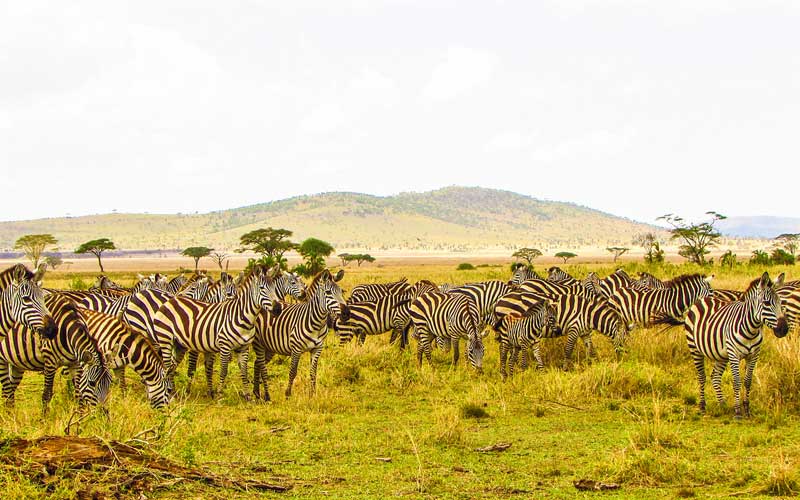
February: Calving Season
The herds are settled and grazing along the plains of the southern Serengeti.
February is peak Calving Season, and the animals don’t move much to give the young enough time to grow strong before they start moving again.
This is a great time to see them. With 8,000 calves born daily (or 400,000 in a 2-3 week period), you are pretty much guaranteed to see hundreds of baby animals frolicking on unsteady legs.
These youngsters also make easier hunting targets for predators, so expect to see lots of lion, leopard, cheetah and hyena stalking through the grasslands.
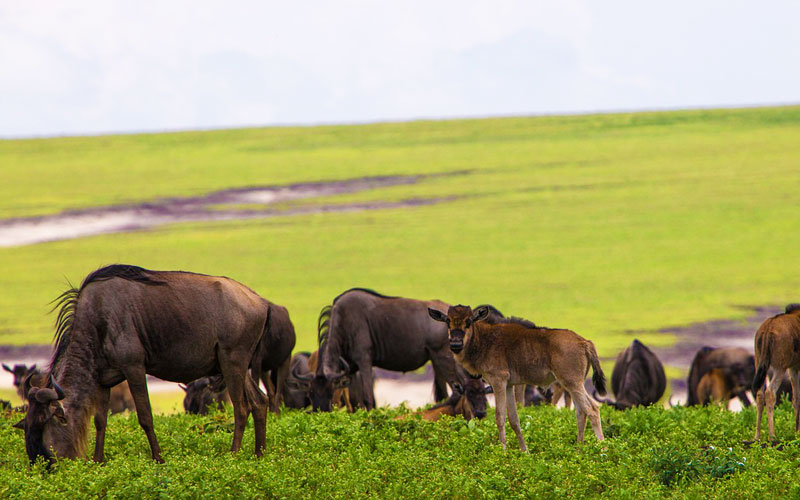
March: End of Calving Season
The tail end of the calving season is in March.
Although some female animals are still giving birth, the majority of the calves are around a month old and more steady on their legs. Still, this is also an excellent time to catch predators on the hunt.
Please Note: Watching the wildebeest migration in the Ndutu Region in the first half of March is a good idea for visitors who want to skip ‘peak season’ here in Tanzania. You are still likely to get great sightings of abundant herds of animals and predators without the crowds and high prices of February. Sometimes, the rains come early, so be prepared for wet weather.
Mobile safari camps are a good choice from January-March as they set up close to the herds. That way, wherever the herds go, you'll soon follow with the help of your trusty guide.
Accommodation tips for calving season
If you're hoping to catch the wildebeest migration in real time, here are some of my great accommodation choices in the Serengeti:
- Ndutu Lodge: The perfect base with easy travelling distance to Goll Kopjes-the number 1 cheetah viewing spot in Africa!
- Mobile camps such as Chaka, Serengeti Safari Camp, Ubuntu and Olakira are operational from January-March. These are good options as they set up close to the herds.
- Alex Walker’s Serian (Serian South) in the Ngorongoro Conservation Area, is outside the Ngorongoro Crater National park, and there is an opportunity for walks, cultural visits, and views of the resident wild dogs.
Where to stay? Here are 5 of my favourite accommodation options in the Serengeti:
- Africa Safari Serengeti Ikoma
- Serengeti Serena Safari Lodge
- Ole Serai Luxury Camp
- Asanja Africa
- Melia Serengeti Lodge
See more Serengeti accommodation options.
April
The long rainy season begins in April.
Although the herds spread out a bit more in search of grazing, they still largely remain in the southern Ndutu and Kusini Plains. The movement of the herds is quite unpredictable as the rainy season begins.
Some years, the herds remain longer in large numbers, but other herds split up earlier and start slowly heading north-west towards the Moru and Simba Kopjes* (one of the best spots to see prides of lions) in smaller groups as the calves become more mobile.
Fun Fact: *Kopjes are small, rocky hills in flat areas.
May: Beginning of the Move
The end of the long rainy season is in May. Herds are on the move! 1.5 million wildebeest, together with thousands of zebras and gazelles, are heading north in huge columns up to 25 miles (40km) long in search of water and grazing.
These herds are passing through the area around Moru Kopjes and west of Seronera. The animals are moving more quickly and also take different routes, making it tricky to see the migration at times.
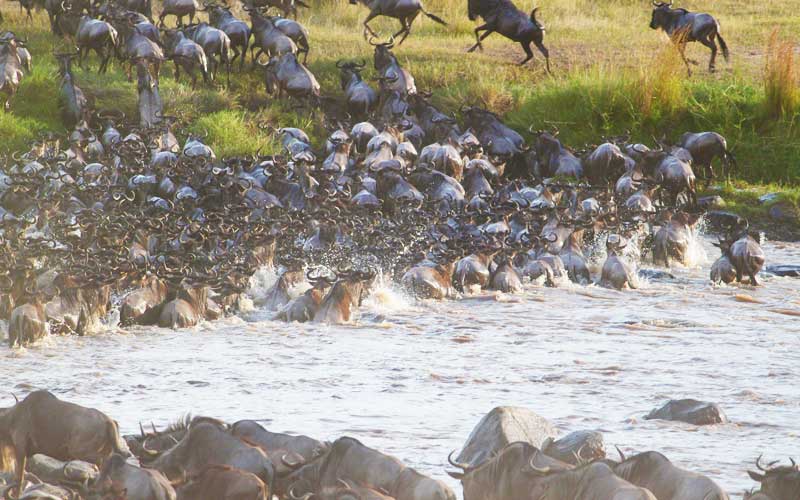
June: Grumeti River Crossing
Herds spread out in June. Some animals move through the western corridor of the Serengeti along the Grumeti River, others head directly north passing through central Serengeti (Seronera Region).
Those to the west often congregate in this area but eventually cross the Grumeti River into the Singita Grumeti Reserves. There is an opportunity to witness a smaller river crossing here and this is also a lesser-visited part of the migration route.
June is also mating season. Males put on displays and compete for the attention of females. With lots of testosterone in the air, it’s a brilliant chance to witness interesting animal behaviour.
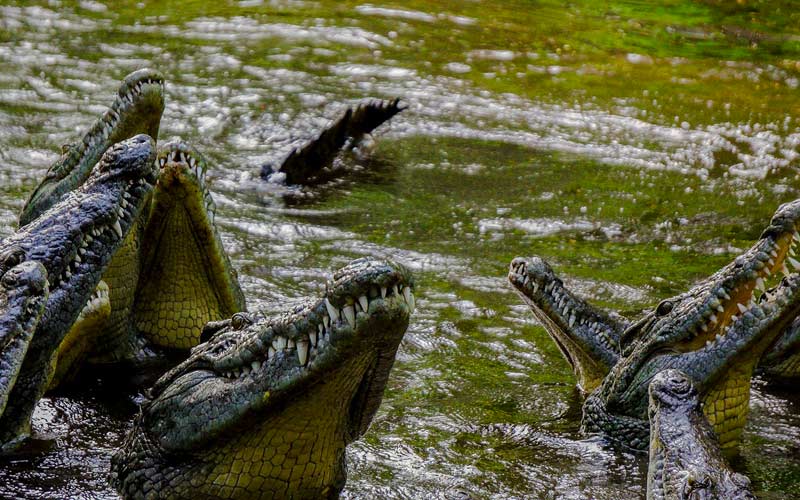
July
In July, the wildebeest continue northwards spread out in a wide front from the western to central Serengeti. Some of the early Mara River crossings begin at this time of year.
My Pro Tip: Read more on for how to go on a combined safari tour in Tanzania and Kenya. It's a great way to see the wildebeest migration at one of its most critical stages.
Did You Know: 80% of the Mara River flows through Tanzania on both sides of its banks. Even though many animals are in Kenya between August and October, northern Tanzania still offers amazing opportunities of seeing river crossings and big herds, while the lodges are generally quieter and running good specials this time of year.
August-October: Mara River Crossing and Crocodiles
Most of the wildebeest have reached the Northern Serengeti, Kogatende and Kenya’s Masai Mara by August through to October.
August is considered the best month for crossings of the famous Mara River where hungry crocodiles wait and serious drama ensues. The decision to cross usually comes down to one animal taking the plunge and a few thousand following.
Amongst all the panic, it’s common for wildebeest to cross the river and re-cross it soon after!
My Pro Tip: September is the best time to see wildebeest in the Masai Mara in Kenya as more than half move north over the border. However, many remain in Northern Tanzania and move back and forth following local rainfall.
November: Beginning of the Return
The short rains should begin, soaking the plains of the southern Serengeti and drawing the herds to leave the northern areas where food is running out. Wildebeest begin making their journey back south to calve and start the cycle again.
What are some interesting Wildebeest Facts?
Here are some interesting facts about Wildebeest:
- The name ‘wildebeest’ comes from the Dutch word meaning 'wild beast'.
- Thanks to the sound it makes, another name for a wildebeest is a Gnu.
- An adult male wildebeest weighs 180kg (400lbs) and a female – 155kg (340lbs).
- Wildebeest live around 20 years.
- Females are pregnant for 250-260 days.
- Calves can walk and run minutes after birth.
- Calves can eat grass after 10 days but will drink milk for 6 months.
- Wildebeest can reach a speed of 80km/50mph.
- Wildebeest are often hunted by humans for their pelts and the meat is eaten, often in a dried and cured form called biltong.
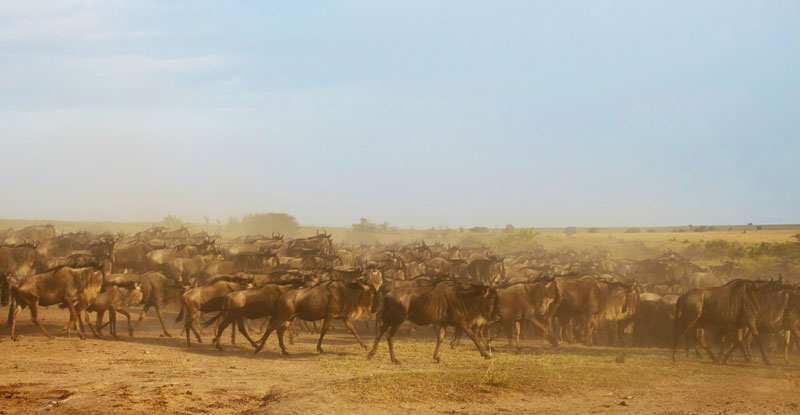
Conclusion
I hope this article answered all your burning FAQs about The Great Wildebeest Migration! But don't take my word for it - you too can follow this remarkable wildlife journey against all odds through the endless plains of the Serengeti.

This guide is incredible! The month-by-month breakdown makes it so easy to plan a trip around the Migration. I can’t wait to experience this breathtaking natural event for myself! Thank you for sharing such detailed and helpful information!
Glad you found this helpful!